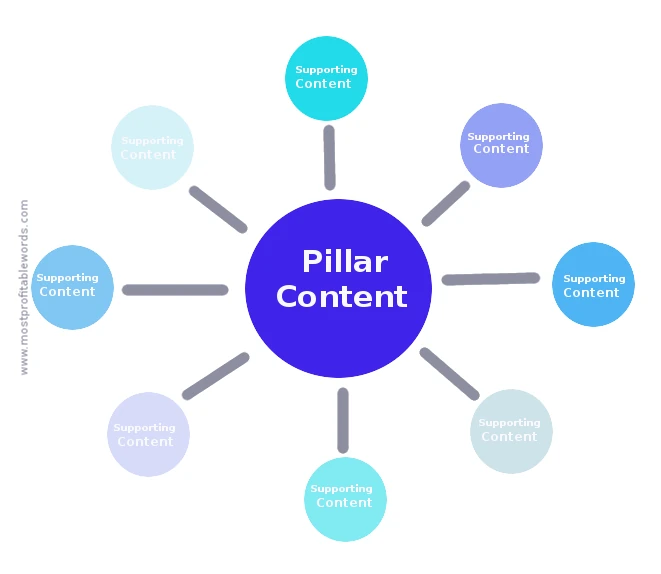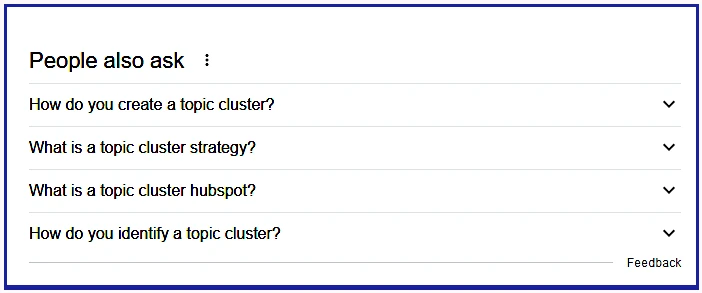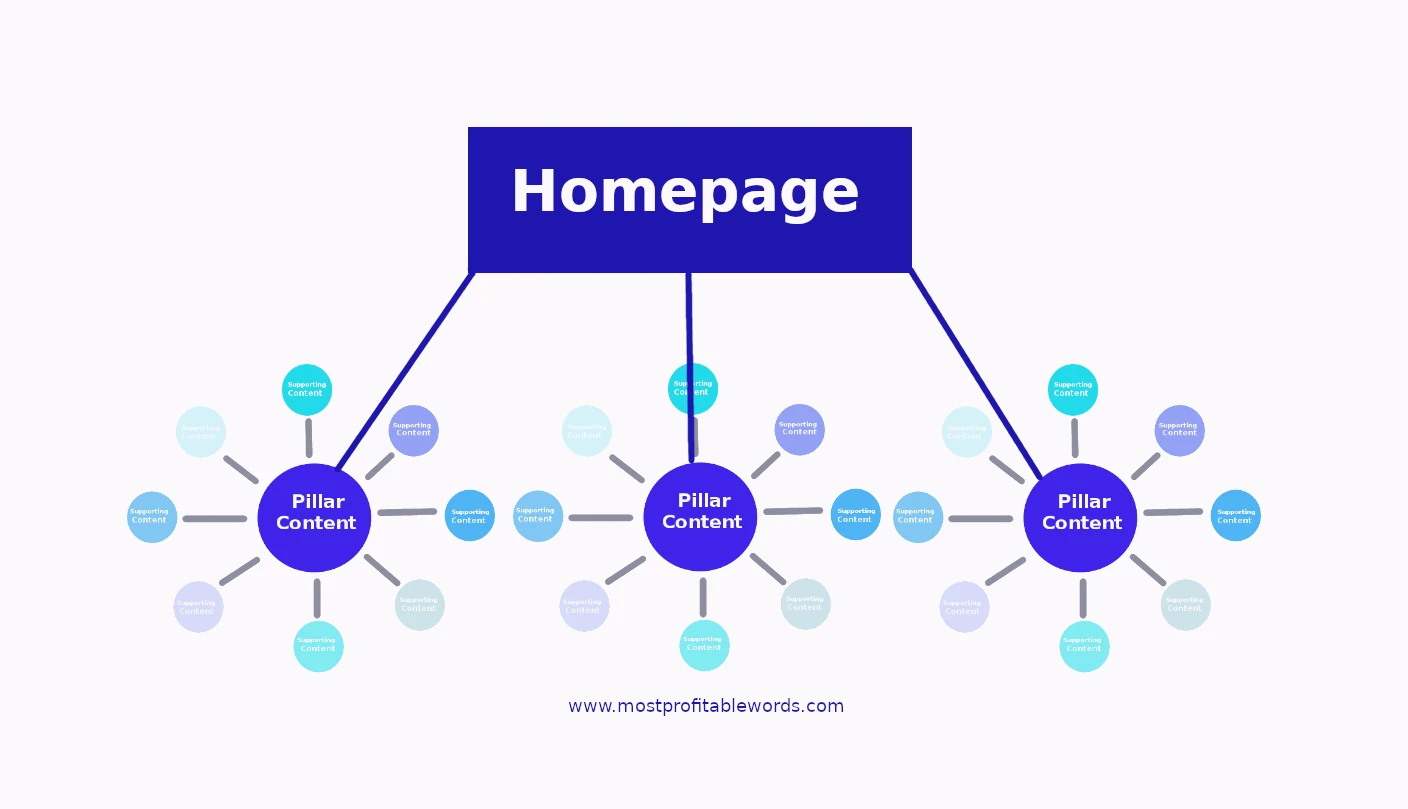Why Topic Clusters Boost your SEO Strategy?
This new SEO strategy shifts the focus from keywords to broader topics and in-depth supportive articles. So, your content can answer peoples' querry properly. As a result your website ranks higher and gets tons of organic traffic.
July 14, 2022
The topic cluster model is a SEO content strategy that groups articles around a particular topic. Internal links from and to a pillar page connect them all.
The topic cluster strategy helps you meet visitors' search query expectations much better, while visiting your website.
Readers move smoothly from one piece of writing to the next naturally, and get access to a complete analysis of a certain topic. As a consequence, visitors stay longer and come back for more later on.
No wonder the topic cluster method not only improves your website's ranking in search engine results but drive more organic traffic to your website, increasing your business activity.
What is a Topic Cluster?
A topic cluster is a group of articles dealing with a specific topic and arranged as a hub and spokes.
A topic cluster consists of a pillar page and several supporting pages about a specific topic. The pillar page or hub provides broad information about a single topic. The cluster pages or spokes explain subtopics in details, tied to important keywords. These articles have to link back to the main page and to each other creating a topic cluster.
These internal links connect all the articles, giving visitors the opportunity to navigate through the cluster easily, get the valuable information they are looking for, and enjoy their visit to your website.

How to Create Topic Clusters
Once you have chosen your broad topic for your pillar page and brainstorm all related keywords, keyword phrases and long-tailed keyword, a list of subtopics turn up to write about.
Determine the Main Topic
To determine the main topics you will write about, you should get those themes that are central to your business. This will give you the opportunity to offer value to your prospects while you achieve your business goals.
Take into account the next questions to determine your main topic
-
What kind of information is my audience looking for?
-
How many subtopics can I get from this main topic?
-
How much does my audience know about this topic?
-
Is this topic aligned with my business goal?
-
What information can my team offer me from their own perspective ?
Make a List of Keywords
Discover all the keywords connected to your main topic. Analyze which keyword phrases are more convenient (highest profit potential)for you and what level of difficulty they represent.
Sneak Up on Your Competition
Learn what key-phrases your competitors are using and how well they are ranking. It's important to identify keywords your competitors are not doing well, so you can succeed quickly.
Study the Top 10 Search Engine Results for your Keyword
Take note of the keywords they use and how their articles are structured. This gives you a great insight of what is popular, what works and what doesn't. You can even check how they have structured their articles to help you choose your subtopics.
List the Subtopics
Together with all the information gathered before, brainstorm possible subtopics.
Imagine you want to rank for “antique sales”. Look for the phrase on search engines and take note of all the information you get: highest ranked content, questions people ask, list of keywords search engine results offer at the bottom of the page.
Use your favorite keyword tool to get more ideas and analyze what's more convenient for you too. Now you are well-equipped to write your content cluster, providing compelling information, answering all the questions people may ask about the topic.
The pillar page should include opportunity for conversion such as downloading a PDF version of your article or a related freebie.

Each subtopic page will focus on a single feature of the main topic, providing greater depth of information. A link should point from and to the pillar page, using a key-phrase as anchor text.
Create an Pillar’s Outline
Create your pillar page outline, taking into account how your competition has organized the same type of content and all the questions people have already asked about your topic. When you ask search engines a question, the search engine results show you search engine paid ads, organic results and section showing what people also ask.
Write the Pillar Page
Go through all your subtitles and only write a general introduction for each part of the article because this is a general presentation of the main topic. Readers would be able to choose whether they want to read all the general sections, or choose only those part they have an urge to read. In that case, they will be able to learn more about that area in a supportive page.
Write Supportive Pages
With the proper outline, now it's turn to write high-quality detailed articles to explain a subtopic of your core topic in details. Add impressive images, facts, quotes, videos and you will succeed.
. Beat your competition with a longer, more detailed article about that topic.
Internal Linking
Link the articles from and to the pillar topic to create the cluster.

Why is Topic Cluster a Powerful SEO Technique?
Topic clusters are important because they offer visitors and businesses many benefits.
-
Grow SEO traffic: Topic clusters improve site architecture and help search engines' web crawlers discover and access your web pages, indexing the important ones according to your robot.txt information.
-
Rank higher: Quality content and internal links expand the influence of keywords used in each subcategory and push the supportive articles to rank higher together with the pillar content.
-
Attract qualified visitor: After competing for visitors' choice on the search engine result, visitors land on a website of their choice.If the website offer well-organized valuable information, they'll stay longer and even may take action. Topic clusters offer visitors a better user's experience. This is seen by search engines as a sign of authority in your industry. The reward is your website ranks higher.
-
Increase conversion: When visitors land interesting and entertaining information they trust your brand and consider you an expert on that topic. Visitors feel more inclined to subscribe to your newsletter or download a free checklist. Topic clusters help you increase your conversion rate.
-
Speed up Content production: Once you have your main topic, the related keywords,you'll get a list of natural subtopics that will provide in-depth information to your website visitors. The original research and cluster architecture will be used for all the material you need to produce.
How do you Organize Topic Clusters around Old Blog Posts
-
Create a list of all your published blog posts if you don’t have one already.
-
Analyze what features of the main topic each old blog post have already covered.
-
Define your topic as a broad area of knowledge to be discussed.
-
Check if you have to write more subtopic articles or if you need to create a pillar page.
-
Chart a topic cluster with your existing content.
-
Look for content gaps.
-
Bear in mind the keywords used in each blog post should be exclusive to avoid keyword cannibalism.
-
Create links from your subcategory articles to the pillar content.
Updating Old Blog Post for SEO
The content on your website gives readers a chance to interact with your business first hand and grants you 74% chances of getting better results, according to Moz.com. Get advantage of this opportunity and offer visitors updated practical and actionable information.
With your topic cluster chart in mind, follow these steps to refresh your old blog posts.
- Check content relevance and extend, modify, delete or edit part of it if necessary.
- Take note of the keywords used, add new related ones.
- Improve your headlines and call to action.
- Change or add pictures or videos.
- Add infographics to present complex topics or downloadable checklists.
- Check for any broken links, spelling and grammar mistakes.
- Create internal links using keywords as anchor text.
Conclusion
Topic cluster is a great tool to improve:
- the quality of your content marketing
- your site architecture
- rank higher in search engine results
- entice your prospects
- save money on SEO
No doubt every blogger who wants to succeed in his/her content marketing strategy needs to refresh old blog posts and create topic clusters with them.
Add a comment